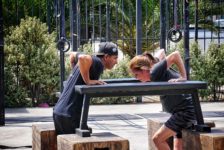
Let’s set the record straight. Peak performance and “form” are the same thing. I hate that word “form” because most people don’t have it, aren’t willing to learn it, and use it as a reason to be un-fit. Poor form, nonetheless, is actually at odds with more weight, faster times, etc. All too often, there’s a prevailing perspective that pins proper movement against bigger numbers, as if you can have just one or the other. Chasing performance doesn’t mean somehow making concessions in movement quality.
This is beginner talk.
It’s beginner talk both literally and figuratively. Most literally, only a novice would say such a thing, because advanced athletes that run fast, throw hard, and lift heavy, know that the bare minimum prerequisite to do so is proper movement. Being out of position means less weight, less speed, and less performance for any athlete with experience. This shows up figuratively because we assume that we can cheat performance, as if proper position is optional for remarkable performances. Proper position is, in fact, necessary. We mistakenly believe that we could do it right and move X number of pounds, or we can risk injury and trade proper posture and position for X pounds plus a little more.
Whether you’re new to training or you’re fifteen years in, your peak expression of performance is available best in optimal positions. In fact, when you look at the best performers you’ll notice that no one gets away with murder. The strongest people in the world move optimally. The fastest people in the world have impeccable form. You cannot win in gymnastics in poor position, and the same is true in the gym. Furthermore, this only becomes more true over time. The future best you isn’t coming with poor movement practices; period.
Logan Gelbrich
@functionalcoach
11/1/16 WOD
5-5-5-5-5
Romanian Deadlifts
AMRAP 8
100′ Keg Carry (AHAP)
5 Strict Pullups
100 Double Unders

